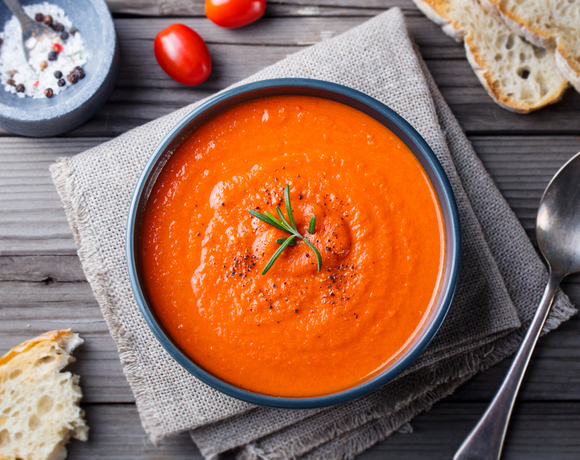
Mindfulness and mindful eating
Mindfulness is a practice based on Buddhism that encourages you to be fully present, embracing the moment without judgement. It is often associated with meditation, deep breathing and other relaxation techniques, and can help reduce anxiety, depression and a variety of chronic stress-related health concerns.
A natural extension of mindfulness is mindful eating, described as savoring your food by using all of your senses, being acutely aware of your hunger, how the food tastes, and when you are becoming full. Mindful eating is also about expressing gratitude, slowing down and even noticing where your food comes from.
If you’ve never really looked at eating that way you are probably not alone—or you may be an American. A 2018 International Food Information Council (IFIC) Food and Health Survey of American adults revealed that only 45% said they always or often pay close attention to the flavors and textures of their food when they eat, while the majority sometimes or rarely do so during a meal. In the same survey, nearly 80% of those surveyed are multi-tasking during a meal or snack.
Savoring meals
Another aspect of mindful eating is taking time to eat, eating more slowly and enjoying every bite of food. An IFIC survey from 2016 showed that nearly 90 percent of Americans on average spend less than 30 minutes eating a meal.

Research from the Organization of Economic Co-operation and Development (OECD) Statista report (2015) showed that people from France, Italy, Greece and Spain spend more than two hours a day eating and drinking, double the time spent by Americans, who spend only one hour and two minutes per day.
Slowing down
According to Lynn Rossy, PhD, a psychologist and author of several books on mindfulness and mindful eating including The Mindfulness-Based Eating Solution, eating more slowly and eating mindfully has many advantages.
“If you take at least 20 minutes to eat at one sitting, your body has time to register the amount of food in your belly and through the digestion process begins to communicate to your brain that you are becoming satisfied.” She says most people eat too fast, eat when distracted and often don’t use hunger or satiety as cues to start or stop eating.

Moving from multi-tasking to mono-tasking
“When we eat, we often are doing something else: on our phone, our computer or watching TV. Multi-tasking while eating gets in the way of appreciating and enjoying our food,” says Lilian Cheung, PhD, RDN, director of health promotion and communication at the Harvard T.H. Chan School of Public Health’s Department of Nutrition, and co-author of the book Savor: Mindful Eating, Mindful Life along with Buddhist Zen Master, Thich Nhat Hanh.
“We ought to be mono-tasking, and that means just eating – eating mindfully,” said Cheung.
“When we do several things at a time,” says Dr. Cheung, “we don’t do any of them really well, and that includes planning meals, shopping, prepping and cooking, eating and checking our hunger and satiety.”
Human beings are not human doings
“We are called human beings — not human doings — for a reason,” said Dr. Lynn Rossy, who has a new mindful eating book out in May (Savor Every Bite: Mindful Ways to Eat, Love your Body and Live with Joy). “When we slow down and take time to just be at least several times during the day we stay more connected to ourselves, and the perfect time to be is when we are eating,” she said.


According to Rossy, “Mindful eating happens before, during and after you eat.”
She says, before you eat, ask yourself if you are even physically hungry. If not, ask yourself what you are really, really hungry for, and try to satisfy the specific hunger you’re having, which may not be for food.
“There are many different layers to our hunger. It is important to stop and ask yourself: Am I hungry, anxious, lonely or tired? Also ask yourself if you are thirsty as thirst is often disguised as hunger,” Rossy said. “When you ask what you are hungry for, you may find it isn’t food, but a need to text or call a friend, rest, or do some deep breathing.”
Taking a personal and global approach
Cheung says her approach to mindful eating is both personal and global.
“I want people to embrace the idea of eating for their own health and the health of the planet. Once you focus on a goal bigger than yourself, it is sometimes easier to embrace.” As a faculty at Harvard T.C. Chan School of Public Health, she says this is a moment for college students to step up and embrace plant-based eating in a big way.
COVID-19 is teaching us a lot, said Cheung. “If we are open to daily pleasures we can be more grateful, slow down and eventually enjoy life more,” said Cheung. “In a way, every day becomes thanksgiving, a time to bless your food every time you sit down to eat.”
Other benefits of mindful eating
Mindfulness and mindful eating have shown promise in helping to manage the following:
- Stress, anxiety and depression
- Feelings of wellbeing (linked to positive emotions)
- Blood pressure and Type 2 diabetes, weight and weight acceptance
- Binge eating and minimizing repeat binges, eating disorders and emotional eating

The joy is in the journey
The purpose of mindful eating is not to lose weight, although it is highly likely that those who adopt this style of eating may lose weight or arrive at a more sustainable weight (a bit higher or lower). The intention is to help individuals savor the moment and the food and encourage their full presence for the eating experience. Mindful eating allows you to be flexible, because it is not a diet. “Mindful Eating is a journey not a destination. Each day you are on a new journey. And just like traveling, which we hope to do soon, you have to keep your eyes on the path. The joy is in the journey,” says Rossy.
8 Steps to Mindful Eating

1) Take a breath: Rossy suggests taking about three slow, deep breaths before you start eating. Take a deep inhale through the nose, then exhale through your nose or mouth. This breathing exercise relaxes you and helps prepare you to eat.
2) Start with silence: Some cultures encourage little or no talking at mealtime. While that may not be practical in the dining commons, consider doing it for just one minute, while eating alone or with friends says Cheung. Like deep breathing, it is a way to center yourself, bless your food and prepare for eating. It is like saying grace or sharing a blessing.
3) Pay attention to hunger: Mindful eating includes the attention you give to your hunger before, during, and after the meal, says Rossy. When you pay attention in this way, you are more likely to start eating when you’re hungry and stop when you are satisfied instead of when you feel too full.
4) Use your senses: Look at your plate and notice all of the colors, shapes and textures. After you eat, ask yourself how you feel: energized or depleted and be as non-judgmental as possible. “Mindful Eating is different every time,” says Rossy. “Notice how your body is responding with kindness” she says. “Remember we do not do it (eat) for a grade.”
5) Slow down – rest between bites: Americans typically eat way too fast. One of the best ways to slow down is to put your fork down between bites. Or, try eating with chopsticks. Cut your food one bite at a time instead of all at once like a mother would do for a child. All of these tips help you slow down.
6) Chew more: Eat foods that encourage you to chew, and then chew more. Soft, mushy overly soft foods can leave you eating too quickly and wanting more.

7) Avoid distracted dining: This is a big one. As Cheung says it is important to focus on one thing (eating) instead of multi-tasking. Set your phone aside and just eat. Try eating one or two meals a day without looking at your phone.

8) Sit at the table: Give yourself a sacred time and place to eat your food, says Rossy. Think TPC (table, plate, chair): Eat at a table, on a plate and in a chair. If you are eating in your dorm room or apartment, create a clutter-free place to eat. Consider adding a cloth napkin, placemat or even a battery-operated candle to set the mood.
This article originally appeared on the Northwestern Dining Blog.
References:
- The Mindfulness-Based Eating Solution (New Harbinger) by Lynn Rossy, PhD
- Savor: Mindful Eating, Mindful Life (Harper One) by Thich Nhat Hanh and Lilian Cheung, DSc, RD
- Eating Mindfully: how to end eating mindlessly and enjoy a balanced relationship with food, second edition (New Harbinger), by Susan Albers, PsyD
- IFIC, Food and Health Surveys, 2016 and 2018.
- (OECD) Eating and Drinking Statista report (2015)
- Fung, T et al., An expanded model for mindful eating for health promotion and sustainability: issues and challenges for dietetics practice. JAND 2016; 116 (7): 1081-1086.
- O’Reilly GA et al. Mindfulness-based interventions for obesity-related eating behaviours: A literature review. Obes Rev 2014; 15 (6): 453-461.
- Timmerman GM, Brown A. The effect of a mindful restaurant eating intervention on weight management in women. J Nutr Ed Behav. 2012; 44 (1): 22-28
- Jordan CH et al., Mindful eating: trait and state mindfulness predict healthier eating behavior. Pers Indiv Differ. 2014; 68:107-111.
- Olson, KI, Emery CF Mindfulness and weight loss: A systemic review. Pschosom Med. 2015; 77 (1): 59-67.



Leave a Reply
You must be logged in to post a comment.